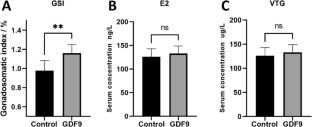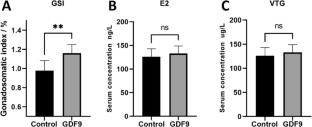Biological Functions of Growth Differentiation Factor 9 in Early Ovarian Development of Japanese Eel (Anguilla japonica)
Abstract
Growth differentiation factor 9 (GDF9) is a member of the transforming growth factor-β (TGF-β) superfamily and is expressed in an oocyte-specific manner. It plays a crucial role in the early stage of ovarian development. Japanese eel (Anguilla Japonica), a spawning migration teleost, has artificial reproduction still under investigation. Aimed at developing a novel method for the successful artificial reproduction of Japanese eel, in the present study, the role of GDF9 in the regulation of early ovarian development was investigated. The Gdf9 gene in Japanese eel was 1293 bp in length, coding for 430 amino acids. Expression analysis in different tissues showed that gdf9 is highly expressed in the ovary, and the gdf9 mRNAs are localized in early developmental oocytes. Injection experiments showed that GDF9 significantly increased the gonadosomatic index in Japanese eel. However, histological observations indicated that GDF9 injection alone was insufficient to overcome the cortical alveolus stage and initiate vitellogenesis in Japanese eel, which is consistent with the lack of significant changes in serum estradiol and vitellogenin levels. Transcriptomic analysis revealed that GDF9 is involved in various molecular functions and physiological processes within the ovary. Overall, our findings suggest that GDF9 plays a regulatory role in the early ovarian development of Japanese eel, possibly by promoting the formation and activation of primordial follicles. These findings offer novel evidence for understanding the regulation of early ovarian development in Japanese eel and provide a valuable foundation for advancing artificial breeding in this species.



 求助内容:
求助内容: 应助结果提醒方式:
应助结果提醒方式:


